Ford Hunger March (1932) Historical Marker
Introduction
Text-to-speech Audio
Images
The marker was originally located on the Fort Street drawbridge
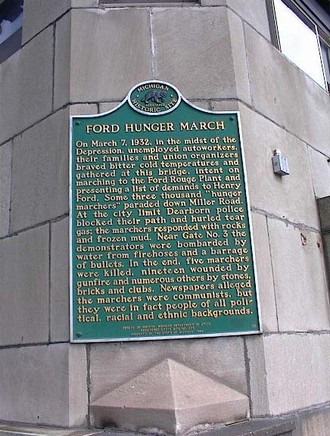
Ford workers flee after being fired upon with tear gas by the Police and Ford's security guards
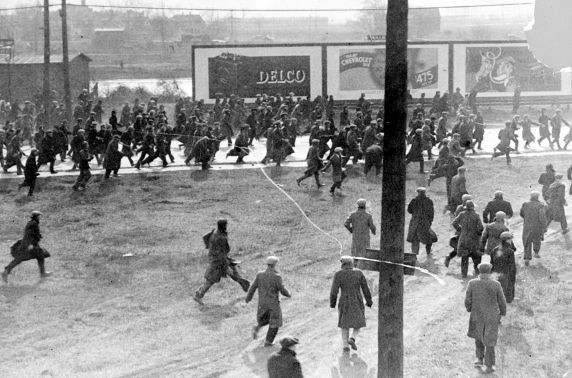
Flyer for a public investigation into the Ford Hunger March by workers' jury
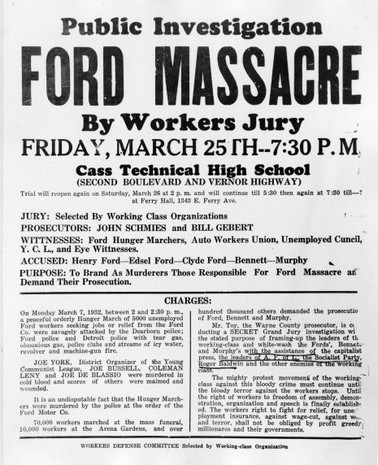
Family and friends stand by memorial wreaths for funerals of four men killed during the march
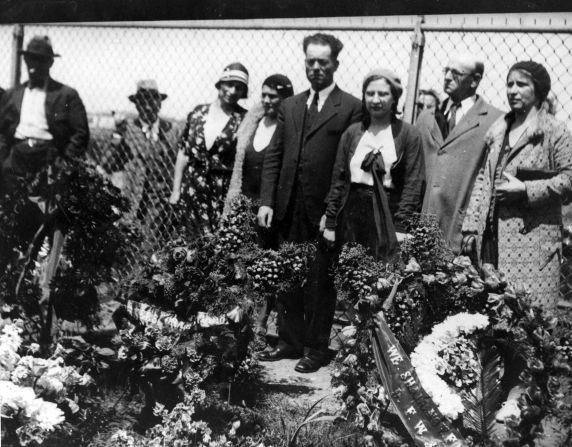
Banner with the slogan of the funeral march held five days later- "Smash Ford-Murphy Police Terror"
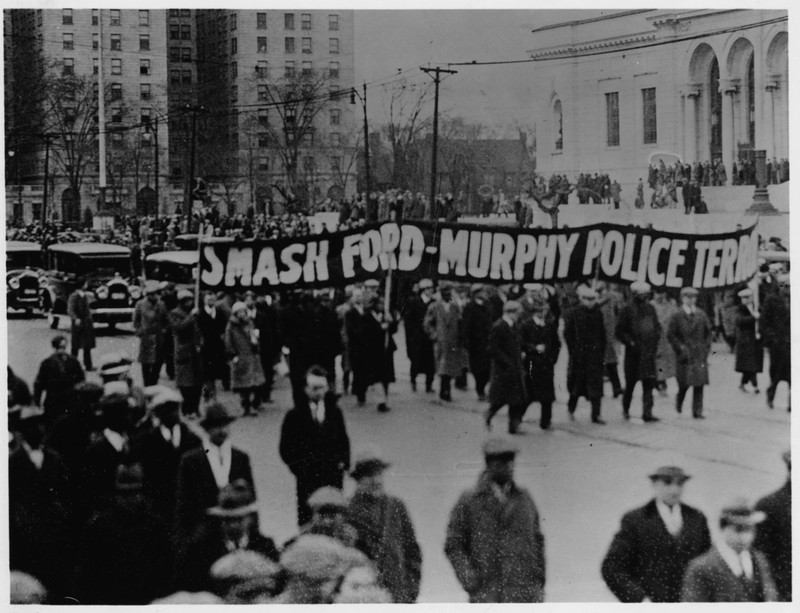
Backstory and Context
Text-to-speech Audio
The morning of March 7, 1932 was described as being one of the coldest in Detroit’s history. As the day progressed, however, it also became known as one of the darkest chapters of labor history in the United States. Following the market crash of 1929, Detroit’s economy had stagnated severely and hundreds of thousands became unemployed within months. That year before the crash, the average annual wage for automobile workers was $1639. Within two years it had plummeted to $757.
In the wake of this economic devastation, a march to the nearby Ford River Rouge Complex- the largest Ford factory in the U.S. at the time- was planned by thousands of unemployed workers for the date of March 7th. The march was organized by the Detroit chapter of the Unemployed Councils- an offshoot project of the Communist Party. The day before, William Z. Foster- a prominent leader within the Party- gave a speech in preparation. In it, he discouraged any form of violence and destruction and highlighted the 14 demands for Henry Ford which had been agreed upon by all of the participating workers. These demands included the rehiring the unemployed, an end to racial discrimination in the workplace, proper healthcare and winter fuel provisions, a ban on corporate spies and the private police force (known as “Security” at the Ford Company), and finally, the right of workers to organize unions.
The march began on the freezing cold morning of March 7th near Dearborn city limits with a crowd of between 3,000 and 5,000 marchers. The plan was to march peacefully over the bridge and down Miller Road until they reached the Ford Rouge River Plant, which was about a mile away. When they reached the city limits, however, Dearborn police attacked the marchers with tear gas and began pushing them back to the bridge. When the marchers responded by hurling rocks and frozen mud, one Dearborn police officer shot into the crowd. Now furious, the crowd regrouped and pushed onward to the factory where they were met by two fire engines which sprayed down freezing water onto them from the overpass. Also at the factory were Ford’s “security” who swiftly joined the police and began shooting into groups of people at random, killing marchers Joe DeBlasio, Coleman Leny, and Joe York and wounding dozens of others.
In an attempt to quell the violence, the march’s organizers called for a retreat. Just as this occurred, Harry Bennett- the head of Ford’s “security”- pulled up in his vehicle, rolled down a window, and shot into the crowd with a pistol. He was immediately pelted by rocks and injured, at which point the Dearborn Police and Ford security men opened fire with machine guns, killing a 16-year-old named Joe Bussell. Marchers who had been too seriously wounded to escape were arrested and handcuffed to their beds in the hospital as they were treated. The event and its aftermath caused a media firestorm. Despite their actions, no police officer or Ford security guard was ever arrested or charged with a crime. William Z. Foster meanwhile, who was vilified by the police department reports and news stories, was suddenly at the center of a national manhunt for his role in the march. He was never arrested. Protests against Ford and the murders in Dearborn sprung up in industrial cities across the country like NYC. Five days later in Dearborn, as many as 60,000 people participated in a march honoring the four people who died. They marched under a common slogan that was seen on many signs that day- “Smash the Ford-Murphy Police Terror”.
A fifth death was counted in the massacre when Curtis Williams, a Black marcher, died from injuries he received at the march three months later. Due to segregation, he was not allowed to be buried in Woodmere Cemetery alongside the four others who died. So instead, his family had him cremated and his ashes were scattered over the graves of his fellow marchers. Many of those who organized and marched in both events were of diverse ethnic backgrounds.
It was not until 9 years later, after the Depression had mostly ended, that Henry Ford finally sat down with UAW union leaders and signed a collective bargaining agreement in response to a ten-day, 40,000 worker sit-down strike. He was the last major automobile manufacturer in the United States to do so. In 1992, the legacy of the Ford Hunger Marchers and those who died in the subsequent massacre was honored with a historical marker plaque that is located on the Oakwood Boulevard/Fort Street drawbridge which they used to cross over into Dearborn that day 60 years prior.
Sources
Edwards, Bobb. Victims of the Ford Hunger March, Find A Grave. July 18th 1998. Accessed October 7th 2020. https://www.findagrave.com/memorial/3217/victims_of_the_ford_hunger_march.
Jackman, Michael. You can commemorate the deadly 1932 Ford Hunger March by donating to this Detroit park, Detroit Metro Times. March 7th 2018. Accessed October 7th 2020. https://www.metrotimes.com/the-scene/archives/2018/03/07/remember-the-ford-hunger-march-by-donating-to-a-detroit-park.
Last Survivor of the Ford Hunger March. Rye, Clayton. United States. 2010. https://youtu.be/5ggu7Cz7hv8.
Sugar, Maurice. Ginger, Ann Fagan. The Ford Hunger March. Edition 1st. Berkeley, California. Meiklejohn Civil Liberties Institute, 1980.
The Detroit News. Michigan History, The Detroit News. March 4th 1999. Accessed October 7th 2020. https://archive.is/20120707022342/http://apps.detnews.com/apps/history/index.php?id=49.
https://historydaystrike.weebly.com/sources.html
https://reuther.wayne.edu/node/7281
https://reuther.wayne.edu/node/7271
https://reuther.wayne.edu/node/7268
https://quod.lib.umich.edu/s/scl/x-lpf.1542/LPF1542?auth=world;lasttype=boolean;lastview=reslist;resnum=358;size=50;sort=scl_wt;start=351;subview=detail;view=entry;rgn1=ic_all;q1=scl
